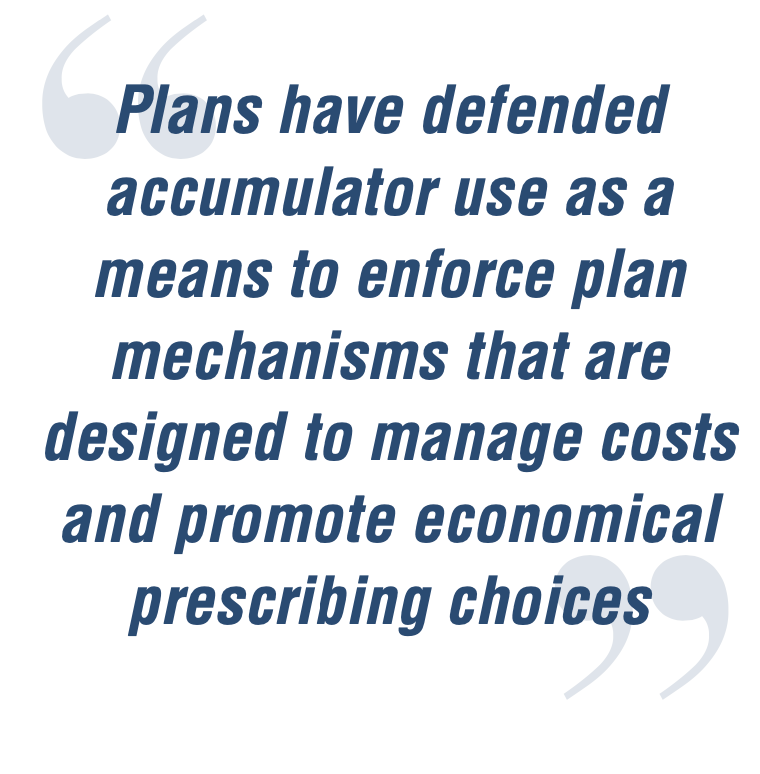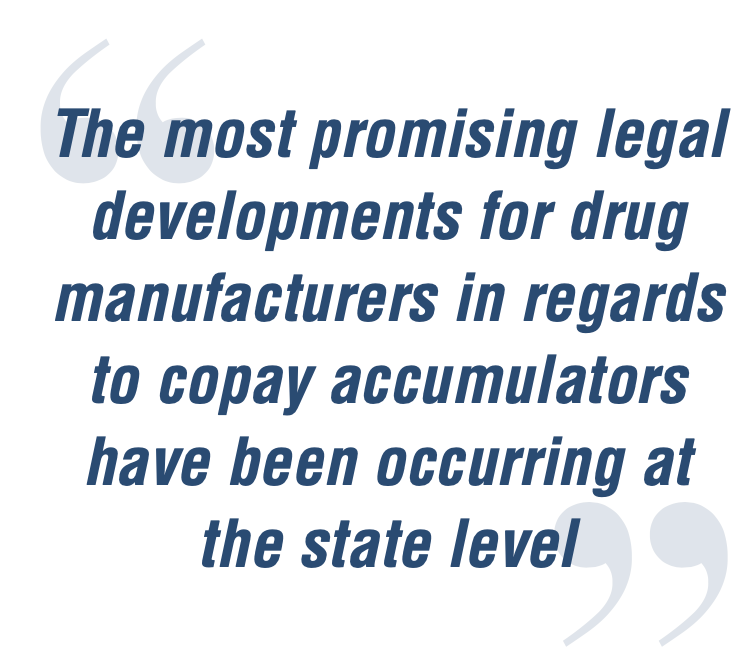Coupon-Program Pivot: Meeting New Legal, Operational Hurdles
Pharma manufacturers may need to upgrade their coupon programs to accommodate for the emergence of copay accumulators and related benefit mechanisms.
John S. Linehan

In 2020, the pharmaceutical industry witnessed a flurry of regulatory and legislative activities addressing drug pricing, distribution, and reimbursement. But while the industry and media have been captivated by high-profile reform initiatives, critical developments regarding drug manufacturer copay coupons have quietly transpired in the background. The legal treatment of coupons and copay accumulators—mechanisms used by pharmacy benefit managers (PBMs) and payers to counter coupons’ impact on plan costs—has evolved in ways that are, on balance, not favorable for manufacturers. These developments deserve closer scrutiny, given the importance of coupons as tools to facilitate access to branded drugs, the ubiquity of coupon use, and the billions of dollars at stake.1 Many manufacturers will need to modify their coupon programs to preserve their value while accommodating new challenges.
The rise of accumulators

For well over a decade, branded drug manufacturers have offered copay coupons that may be used by commercial plan beneficiaries to cover their cost-sharing obligations at the pharmacy point-of-sale.2 However, in recent years, health plans and PBMs have developed copay accumulators and related benefit mechanisms3 to mitigate the cost-impact of coupons by barring them from counting against a beneficiary’s deductible or annual out-of-pocket maximum. After the coupon’s value is expended, the beneficiary must then cover the entire amount of any remaining deductible before plan benefits are triggered. By employing accumulators, plans are able to reduce their financial liability by deriving cost-savings from coupon use and from beneficiary cost-sharing payments before furnishing drug coverage.
Given their financial benefits to plans, the employment of accumulators and related plan mechanisms has exploded in the past several years. Accumulators have also generated controversy, as plans and PBMs have used them to shift costs to beneficiaries, and sometimes in an abrupt manner. On the other hand, plans have defended accumulator use as a means to enforce plan mechanisms that are designed to manage costs and promote economical prescribing choices.
Two steps back: New federal policies present challenges
In April 2019, drug manufacturers were briefly encouraged when the federal government made its first foray into regulating plan accumulator programs. The Centers for Medicare and Medicaid Services (CMS) issued a final rule that would have modified the Affordable Care Act’s (ACA’s) essential health benefits (EHB) rules to heavily restrict plan and PBM employment of copay coupon accumulator programs.4
However, a few months later, the government suspended its policy, claiming that it could lead to conflicts with a separate set of IRS rules governing the qualification of high deductible health plans (HDHPs) as health savings accounts (HSAs). Then, in May 2020, CMS issued a new rule in which it reversed its position on accumulators and the treatment of coupons under the EHB rules. Citing confusion that resulted from its 2019 rule, CMS’s new rulemaking allows (but does not require) plans to utilize accumulators to prevent coupons from accruing to a beneficiary’s maximum out-of-pocket limits.5 As a result, plans and their contracting PBMs enjoy wide flexibility to develop coupon policies that comport with applicable legal requirements, including those imposed under state law or the IRS rules for HSA-eligible HDHPs. This policy has cemented the legality of accumulators under federal law, thereby boosting plan efforts to counteract and deter coupon use.
Manufacturers were served with an additional setback in December 2020, with CMS’s finalization of a new policy regarding the treatment of copay coupons and other forms of patient financial assistance under the Medicaid Drug Rebate Program (MDRP).6 Historically, drug coupons and other forms of patient assistance have generally been excluded from the calculation of “best price” and “average manufacturer price” (AMP), which are used to determine the amount of rebates manufacturers must pay to the government to participate in the Medicaid program.In the rule, CMS stated that to qualify for these exclusions, such patient assistance must be fully passed on to the consumer and that, from the agency’s perspective, this does not occur where a plan’s accumulator prevents a coupon from applying to a deductible. CMS posits that in these situations, the value of the coupon is not truly passed through to the consumer, but is instead partially transferred to the plan.
Under CMS’s new policy, a manufacturer will need to determine whether a plan is applying an accumulator to its coupon and, where this occurs, ensure the coupon is included (rather than excluded) from best price/AMP calculations, meaning that the manufacturer faces higher MDRP rebate liability. In observance of the dramatic change to the status quo, and out of concern over upending patient financial assistance during the COVID-19 pandemic, CMS delayed the implementation date until Jan. 1, 2023. It states that during this interim period, manufacturers will need to develop new systems and arrangements designed “to ensure the full value of assistance under their manufacturer-sponsored assistance program is passed on to the patient.”6
In the event manufacturers are unable to make suitable accommodations to account for the logistical difficulties of reliably tracking coupons and identifying accumulator use, some manufacturers may feel compelled to take unfavorable steps. For instance, some may default to include all coupons in best price and AMP to avoid incurring penalties for non-compliance or reduce their patient assistance offerings altogether to avoid increased Medicaid rebate liability.
Favorable developments regarding transparency and state law
CMS’s rulemaking regarding accumulators under the EHB and Medicaid best price rules will further embolden health plans and PBMs to use accumulators to combat coupon use. Nevertheless, manufacturers may gather some relief from other legal developments in 2020, including new plan transparency initiatives and the growing number of state law restrictions.
In October 2020, the federal government issued a final rule imposing wide-ranging transparency requirements for commercial health plans that involve, among other things, information on plan cost-sharing.7 Under the new rules, health plans are now required to disclose whether or not copay assistance or other third-party payments are included in the calculation of a beneficiary’s deductible or annual out-of-pocket maximum. In essence, this constitutes a requirement that plans disclose whether or not they utilize accumulators or related programs to prevent coupons from applying to cost-sharing requirements. But while it imposes the first bright-line requirement for plans to disclose accumulator use, the rule’s practical impact should not be overstated. Most large and sophisticated plans and PBMs already recognize that disclosure of these programs should be made to mitigate potential legal risks under the Employee Retirement Income Security Act (ERISA) of 1974 and consumer protection and anti-discrimination laws.

The most promising legal developments for drug manufacturers in regards to copay accumulators have been occurring at the state level. While the federal law has evolved to largely permit plans and PBMs to impose accumulators in the commercial setting, a handful of states—Arizona, Georgia, Illinois, Virginia, and West Virginia—have passed laws that prohibit or heavily restrict employment of accumulators by fully-insured health plans.8
In the meantime, patient and prescriber advocacy groups have been aggressively promoting similar changes and over 20 state legislatures have considered bills that would impact accumulators. The laws are alike in broadly restricting accumulator use by requiring plans to count any payments made on behalf of a beneficiary (including from manufacturers) against cost-sharing obligations. However, some of the laws differ in their scope of application, and whether they apply to PBMs (along with plans), or to drugs covered under the medical benefit (as well as the pharmacy benefit); also, some of the laws include exceptions where a generic is available.
Looking forward: Meeting new challenges to coupon programs
In 2020, the industry witnessed important developments at the federal and state levels regarding the regulation of copay accumulator programs, which will have far-reaching impacts on drug manufacturer coupon programs. While the regulatory trends at the federal and state levels have diverged, on balance, plans and PBMs have been encouraged by the federal government’s relaxing of restrictions. Business trends have progressed accordingly—not only has accumulator use mushroomed in recent years, but some plans are now experimenting with accumulators to control coupon use for physician-administered drugs covered under the medical benefit (in addition to drugs covered under the pharmacy benefit).
Given the massive impacts that accumulators can ultimately bear on their bottom line, drug manufacturers, like other affected stakeholders, will need to vigilantly monitor legal and operational developments in this quickly evolving area. The federal government’s mercurial policymaking underlines the ongoing need to inform lawmakers about the real-world consequences of their reforms. In the meantime, key business and operational developments are likely to transpire in the next three years in advance of the Jan. 1, 2023 implementation date for the new MDRP rules affecting coupons. Manufacturers face an array of options but no clear roadmap or precedent to guide their next steps. CMS intimates that manufacturers may need to better collaborate or coordinate with health plans and PBMs over coupons and accumulators.9 But given the contentious nature of manufacturer-plan interactions over coupons, the business war between these opposing factions may instead intensify. In any event, all stakeholders—manufacturers and plans alike—will need to engage with legal and operational experts in this area to navigate the uneven landscape and react appropriately.
References
- By 2015, copay coupons were being offered on more than 700 banded drug products and manufacturers are estimated to have furnished around $13 billion in coupons in 2018. See Jonathan Gray, Manufacturer Coupons and Patient Assistance Programs, The Actuary (May 2020); https://theactuarymagazine.org/manufacturer-coupons-and-patient-assistance-programs/.
- Coupons are prohibited under federal healthcare programs as unlawful inducements under the Anti-Kickback Statute and the beneficiary inducement provision of the Civil Monetary Penalties Law.
- In addition to copay accumulators, plans have developed similar mechanisms called copay maximizers (or variable copay programs) to thwart the impact of coupon use. Under a copay maximizer, the plan increases a drug’s copay amount so that it approximates the coupon’s monthly value. The total value of the coupon is then applied consistently during the benefit year but does not count against the beneficiary’s cost-sharing obligations.
- 84 Fed. Reg. 17454, 17544 (Apr. 25, 2019).
- 85 Fed. Reg. 29164, 29231 (May 14, 2020).
- 85 Fed. Reg. 87000, 87048-57 (Dec. 31, 2020).
- 85 Fed. Reg. 72158, 72203 (Nov. 12, 2020).
- Due to ERISA preemption, states generally lack the authority to regulate self-insured ERISA plans under their insurance codes.
- “[O]ur expectation is that manufacturers will work with their contracted patient assistance brokers, prescription claims processing switches, health plans and their contracted PBMs to ensure that they have the information necessary to comply with this regulatory requirement.” 85 Fed. Reg. at 87054.
John S. Linehan, member of the firm in the healthcare and life sciences practice group at Epstein Becker & Green

MDMA Therapy for Mental Health Conditions: Do the Benefits Outweigh the Risks?
October 25th 2024Despite a recent FDA Complete Response Letter issued to Lykos for midomafetamine capsules for the treatment of post-traumatic stress disorder, experts believe that the future is bright for psychedelic drugs that treat mental health conditions.
Securities Litigation Arising from Alzheimer's Drug Treatments
September 25th 2024The legal challenges surrounding Biogen’s Aduhelm and Cassava Sciences’ simufilam underscore the ongoing difficulties in Alzheimer's drug development, leading to securities litigation over allegedly misleading statements about trial results and commercialization efforts.